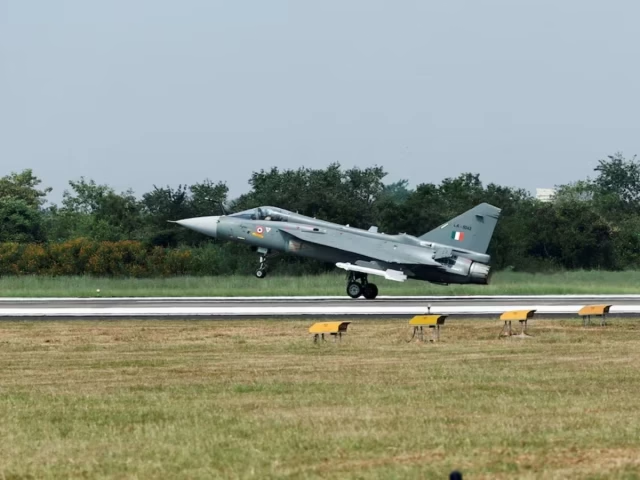Hindustan Aeronautics Limited (HAL) Tejas Mark 1A, a light combat aircraft takes off ahead of its maiden flight at HAL Nashik, India, October 17, 2025. PHOTO: Retuers
ISLAMABAD:
The crash of the Tejas lightweight, indigenous combat aircraft, developed by India’s Hindustan Aeronautics Limited (HAL) and the Defence Research and Development Organisation (DRDO), has raised serious concerns about the fighter jet’s operational readiness, safety standards, and long-standing technical difficulties.
The crash, which occurred during a public aerobatic display at the Dubai Air Show, has led aviation experts and military analysts to weigh in on the series of systemic failures that have plagued the Tejas programme for decades. Though the exact cause is still under investigation, experts suggest a combination of technical malfunctions, systemic issues in development, and operational pressures may have played a critical role in the crash.
Aviation experts point to a history of developmental delays, chronic quality control problems, engine integration difficulties, and a general dissatisfaction from the Indian Air Force (IAF) regarding the aircraft’s performance. These issues have, over time, resulted in a warplane that has struggled to meet both internal expectations and external demands.
The Tejas programme, which began in the 1980s, was touted as India’s flagship indigenous fighter, a symbol of the country’s self-reliance in combat aviation. However, nearly four decades of development have been marred by delays and technical setbacks. The aircraft has only become operational in the past decade, and even then, it has been beset with issues.
The most recent in a series of concerning incidents was the crash of a Tejas warplane near Jaisalmer in the Indian state of Rajasthan on March 12, 2024, following an engine seizure caused by an oil-pump malfunction. Preliminary investigations pointed to this failure as a critical fault rather than pilot error.
The crash highlighted the vulnerability of the Tejas, a single-engine aircraft, to catastrophic failure when its propulsion system malfunctions. It served as an early warning that the aircraft’s engine remained unreliable despite years of development.
According to aviation and aeronautics experts, the ongoing issues with the Tejas’s engine are compounded by procurement and supply-chain problems. Despite HAL’s efforts to integrate indigenous systems, the aircraft has relied on imported GE F404/F414 engines, which have faced delayed deliveries and occasional gearbox and accessory shortages.
These delays have forced the IAF and HAL to stagger production timelines, delay deliveries, and scramble for interim solutions – all of which have compressed testing schedules and created operational risks. All these concerns were confirmed at the Dubai Air Show crash, prompting aviation experts to draw connections between the failure at Jaisalmer and the more recent crash.
The Tejas was initially conceived as a multi-role fighter jet to replace the aging fleet of Russian MiG-21s in the IAF. However, the programme’s developmental trajectory has been far from smooth. The timeline, which spans over 40 years, has been plagued by unstable design requirements, technological gaps, and an inability to freeze a final configuration for the aircraft.
Despite these issues, the Tejas continued to be showcased at international air shows as a symbol of India’s growing defence capabilities. However, the aircraft’s ability to meet the stringent operational demands of the IAF has remained in question, as major issues persist in radar integration, defensive systems, and combat survivability.
Another major contributing factor to the Tejas’s operational issues is the state of HAL’s manufacturing processes. Over the years, HAL has faced recurrent quality control issues, which have compromised the safety and reliability of the Tejas fleet.
HAL has struggled to meet production targets, delaying the induction of operational aircraft. Despite huge investment, HAL’s production capacity has been insufficient to meet the demand for Tejas jets within the IAF.
Reports of fluid leaks, panel misalignments, premature wear on seals, and grounding issues have haunted the Tejas fleet. These defects suggest lapses in HAL’s quality control processes and a failure to ensure that the aircraft meets basic operational standards before being delivered.
Meanwhile, HAL’s reliance on manual procedures instead of automated checks has contributed to human error during assembly and maintenance. The lack of automation in quality control has made it difficult to maintain high standards of production, which is critical for military aircraft.
The Dubai crash exposed these deficiencies, as visible fluid leaks and other mechanical defects were apparent before the flight. These defects should have been addressed during pre-flight inspections, but the rushed nature of the demonstration, combined with ongoing issues in maintenance and quality control, led to a catastrophic failure mid-flight.
The Tejas was originally designed to be powered by the indigenous Kaveri engine. However, the failure of the Kaveri engine project forced HAL to rely on foreign engines – the GE F404/F414 – which were not optimally suited for the aircraft’s airframe. This mismatch has resulted in several performance issues, including thrust limitations, aerodynamic disruptions, and increased maintenance complexity.
These performance constraints were particularly apparent during the aerobatic display at the Dubai Air Show, where the Tejas was pushed to its limits, exacerbating any underlying issues with the engine or flight systems.
The Tejas uses a digital fly-by-wire system, a modern feature that should provide greater control and precision in flight. However, the system has faced significant instability issues since its introduction, including excessive sensitivity, software patches, and pilot-autopilot discrepancies.
Given the sensitivity of the Tejas’s flight control system and the unresolved software issues, it is likely that the crash in Dubai was caused, in part, by the combination of these factors, making it harder for the pilot to regain control during the high-stress aerobatic routine.
According to defence analysts, political pressure has also played a huge role in the Tejas programme’s trajectory. As part of India’s “Aatmanirbhar Bharat” (self-reliant India) and “Make in India” initiatives, the Tejas has become a symbol of national pride. However, this political pressure has often overshadowed technical concerns, leading to the aircraft being showcased at international air shows despite ongoing issues with its design and performance.
They believe the desire to project strength and technological prowess on the global stage has led to a situation where the aircraft was pushed into demonstrations before it was fully operational, downplaying its technical deficiencies in favour of national optics. This approach, while boosting India’s image, has clearly compromised the safety and performance of the Tejas.
The analysts say that the Dubai crash is a reminder of the deep-rooted issues within India’s military-industrial complex. It underscores the importance of prioritising technical readiness, quality control, and safety over political considerations in defence development.
The Tejas programme, which was meant to be a symbol of India’s self-reliance, has instead become a case study in how repeated technical failures, compounded by political pressures and systemic inefficiencies, can lead to catastrophic outcomes.









